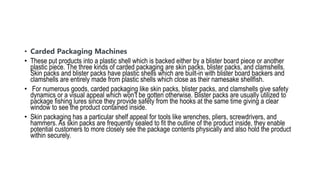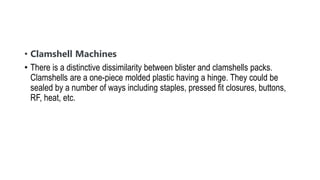Confectionery equipments and packing.pptx
- 1. Confectionery Equipments Dr. Prajya Arya, SVPUAT
- 2. ŌĆó Mixer: stainless steel beater, whisker for whipping at desried rate ŌĆó Roaster: obtain high quality dry fruits, sell directly from industry ŌĆó Manual Grinder: chopped dry fruits, biscuits, nougat ŌĆó Sugar mill: processing granulated sugar in icing sugar ŌĆó Sugar coater: use sugar to coat hazelnut, almonds, peanuts and whole grain nuts ŌĆó Coating machine: used for production of dragee, Jordan almonds, colored products
- 3. ŌĆó Flour sifter ŌĆó Dough mixer ŌĆó Dough divider ŌĆó Rounder ŌĆó Intermediate proover ŌĆó Measuring tools: dry measuring cups, dry measuring bowl, measuring spoon, liquid measuring cups ŌĆó Dough moulder ŌĆó Bread cooler ŌĆó Bread slicer ŌĆó Packaging machine
- 5. ŌĆó Filling Machines ŌĆó Filling machines or fillers are utilized for packaging, mostly for beverage and food but for other products also. These are used to fill either a pouch or a bottle, depending on the product. The following are the most popular. ŌĆó Auger or Agitator Filler ŌĆó Augers or agitator fillers are made to fill dry mixes, like flour and sugar. The fillers have a hopper in a coneŌĆÖs shape which holds the mix and fills it in a pouch utilizing an auger conveyor which the agitator controls. The mix is put in a pouch which is made from poly or paper which is made in a collar and the pouch is sealed by a consecutive number of dies and heaters. The interface which has the process applying the powder is of key importance to guarantee an efficient filing.
- 6. ŌĆó Flow Fillers ŌĆó Constructed for oils, liquids, and thin edible products. These fillers are constructed when they fill a tub or bottle that enters the machinery. This emits the open bottle back on another conveyor machine for sealing. ŌĆó Vibratory Weigh Fillers ŌĆó These offer a blend of speed, versatility, and accuracy for linear feeders. Every weighing-hopper is constructed to accommodate the requirements for precise weights.
- 7. ŌĆó Tablet Fillers ŌĆó These are constructed for products which are counted by portions instead of weight. These are constructed for small bottles like other flow fillers. The fillerŌĆÖs hopper is set up to allow scan counting of candy pieces or tablets. ŌĆó
- 8. ŌĆó Positive Displacement Pump Filler ŌĆó Positive displacement, pump filling machinery handles a broad range of container dimensions, fill volume, and types of product. While originally constructed for filling gels, lotions, and creams, these fillers also accommodate water heavy and thin paste products. Some of the products this machinery simply fills are heavy sauces, cosmetic creams, hair conditioners and thick shampoo, honey, paste cleaners, hair gels, and car wax.
- 9. ŌĆó Vertical Form Fill Sealing Machine ŌĆó Vertical form fill sealing machinery is a type of automatic assembly line packaging system, normally utilized in the food packaging industry, and a wide range of other products. The machine makes stand-up pouches and plastic bags out of a flat film roll, while filling the bags simultaneously with products and sealing filled bags. Both liquids and solids can be bagged utilizing this packaging system. The machinery is loaded with a continual flat plastic film roll, which has had labeling and artwork on the interior or exterior of the film. While plastic is the most normally utilized packaging material in the food industry, the machinery can also be utilized to make continuous metalized paper, film/foil, and fabric products vessels by altering the edge seaming/sealing methods. For other products the film might first be put through a sterilizing chemical wash and drying before using in the packaging system
- 10. ŌĆó Cartoning Machines ŌĆó Cartoning machinery or cartoner, is packaging machinery that makes cartons: close, folded, erect, sealed and side seamed cartons. Packaging machines which make carton board blanks into cartons filled with products or bags of products or many products into single cartons, after the filling process, the machinery engages its slots or tabs to put adhesive and cover both the ends of cartons wholly sealing the carton. ŌĆó Cartoning machines may be grouped into two types: ŌĆó Horizontal cartoning machines ŌĆó Vertical cartoning machines ŌĆó Cartoning machines which pick single pieces from stacks of folded cartons and erect them, fill them with products or bags of products or many products horizontally via open ends and close by tucking carton end flaps or applying adhesive or glue. The products may be pushed into the cartons by pressurized air or through mechanical sleeves. For other applications, the product is put manually into the carton. This kind of Cartoning machinery is commonly used for packaging confectionery, foodstuffs, medicine, sundry goods, cosmetics, etc
- 11. ŌĆó Pallet Wrappers or Stretch Wrappers ŌĆó Pallet wrappers are pervasive in numerous packaging lines worldwide. Having substantial cost savings for big operations over wrapping manually, utilizing pallet wrappers also exploits the stretching capabilities of the stretch film. This guarantees saving both money and time. ŌĆó A stretch wrapper helps ensure that exact load containment for wrapping operation is being used. For load containment, three variables are considered: ŌĆó The amount of layers or wraps on the load ŌĆó The wrapping force ŌĆó The thickness or gauge of the film ŌĆó Turntable Wrapper ŌĆó With this machine, a pallet is placed on a turntable that rotates while a wrap applying system distributes the stretch wrap onto the load. The wrap delivery system usually starts at the bottom and up to the top then back to the bottom. ŌĆó
- 12. ŌĆó A turntable wrappers is one of the most common types of stretch wrapping machinery and can be set up to work harmoniously with different kinds of applications. ŌĆó Straddle Wrapper ŌĆó With straddle wrappers a load stays fixed while a wrap applying system rotates around the load. This type of wrapper wraps light weight and heavy unstable loads and is able to wrap low to high volumes. ŌĆó
- 13. ŌĆó Orbital Wrapper ŌĆó Orbital wrappers are also referred to as ŌĆ£ringerŌĆØ wraps the pallet by going under and over the load as the load moves on a conveyor machine into the machinery. Orbital wrappers are mainly utilized for packaging oddly shaped or flattened products like rolled carpets, pipes, and windows. ŌĆó Ring Straddle Wrapper ŌĆó These are fast wrappers that are typically capable of wrapping 200 loads an hour. These machines are at times found in the beverage and toiletry industries. They are exceedingly specialized equipment and only contribute a small part of stretch wrapping machinery presently in use. ŌĆó They enable the load to stay fixed while the wrap applying system rotates around the pallet.
- 14. ŌĆó Shrink Tunnels ŌĆó A shrink tunnel is a staple of many packaging lines. When configured with the correct temperature settings, it is a packaging powerhouse. It works by conveying a product that has been put inside a shrink bag produced from a shrink film via a hot tunnel which causes the heat sensitive film to shrink evenly around the item inside. ŌĆó Airflow from the machinery avoids the products from becoming too hot. If a product is mostly sensitive, particularly heat sensing tapes are put through the machinery to identify if the product is suitable for packaging using a heat tunnel. ŌĆó If the tapes identify that the heat tunnel is inappropriate for packaging a product, other choices can be recommended by the packaging professionals. ŌĆó
- 15. ŌĆó Carded Packaging Machines ŌĆó These put products into a plastic shell which is backed either by a blister board piece or another plastic piece. The three kinds of carded packaging are skin packs, blister packs, and clamshells. Skin packs and blister packs have plastic shells which are built-in with blister board backers and clamshells are entirely made from plastic shells which close as their namesake shellfish. ŌĆó For numerous goods, carded packaging like skin packs, blister packs, and clamshells give safety dynamics or a visual appeal which wonŌĆÖt be gotten otherwise. Blister packs are usually utilized to package fishing lures since they provide safety from the hooks at the same time giving a clear window to see the product contained inside. ŌĆó Skin packaging has a particular shelf appeal for tools like wrenches, pliers, screwdrivers, and hammers. As skin packs are frequently sealed to fit the outline of the product inside, they enable potential customers to more closely see the package contents physically and also hold the product within securely.
- 16. ŌĆó B lister Packaging Machines ŌĆó They come in semi-automatic and automatic models. They have rotating sections which hold the plastic part of the blister pack in position. ŌĆó As the section of the machinery rotates, empty plastic shells either automatically or manually are filled with the product. Next, blister board backers are put on the plastic shellŌĆÖs back either by machine or hand with a glue and the blister pack is done. ŌĆó Skin Pack Machines ŌĆó While blister packs and skin packs share similarities, the machinery that makes the two are very different. Skin pack machinery has a platform for resting the backing substrate or blister board. The products to be packaged are placed on the board. ŌĆó The machine puts a heated soft plastic layer which shapes itself over the products. Vacuum sealing is often implemented to guarantee a tight fit. The substrate then binds to the heat-seal layer on the cardboard.
- 17. ŌĆó Clamshell Machines ŌĆó There is a distinctive dissimilarity between blister and clamshells packs. Clamshells are a one-piece molded plastic having a hinge. They could be sealed by a number of ways including staples, pressed fit closures, buttons, RF, heat, etc.

















